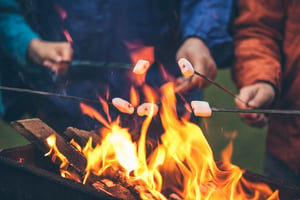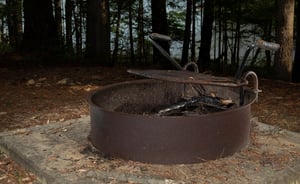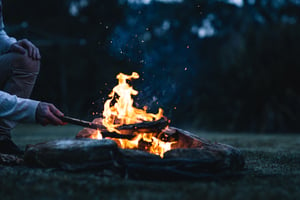
August is the peak time for camping. It’s the last full month of summer, and many people take advantage of this before hunkering down for the fall and winter.
Of course, no camping trip is complete without a cozy campfire. Campfires are fun to look at, and even more fun to cook with or roast marshmallows over.While campfires are fun, it’s important to recognize the risks involved and make sure you’re taking precautions to prevent burns or even wildfires.
In this blog, we’re sharing tips to make sure your campfire is safe, so that your camping trip goes off without a fire emergency.
Selecting a spot for your campfire
One of the most important steps is choosing the right spot to start your fire. Before you do anything, make sure that a fire is allowed in your area. If it’s dry, there might be burn bans in effect, and you should always check the local ordinances before considering starting a fire.
Next, check to see if your campsite has an existing fire ring or pit. If so, start your campfire there, as that’s the safest spot. If there’s not, then select a site that’s at least 15 feet away from anything flammable, including tent walls, shrubs, trees, and other materials. Be sure to also look up to check for any hanging branches.
You want to choose an open, level location for your campfire. Pick a spot away from brush, decaying leaves or logs. Keep the wind in mind, too. You want to do your best to shelter your fire from wind, or at the least be aware of which way the wind is blowing – your sparks will blow that way too.
Preparing the fire
Once you’ve found the right spot, the next thing to do is build your fire. You’ll need a shovel for this, and you should always take one with you when camping.
when camping.
If you need to dig a pit, do so, and then ring the pit with rocks. This will help keep your fire contained and safe. Check again to be sure a 15-foot area of space is free of any fire hazards around your fire.
You want to keep your shovel, a bucket and a water source (or bucket filled with water) close at hand in case anything goes awry. If you gather extra wood, stack it away and upwind of your fire. Finally, if you use a match, toss the match into the fire after starting it – not away onto the ground, as this could create a second fire.
Maintaining and extinguishing

While your fire is burning, make sure you never put anything into the fire other than wood. Glass, cans or pressurized containers can explode and injure you or start a wildfire; it’s not worth the risk.
Keep in mind that you don’t have to have a huge, roaring fire for it to be effective for cooking or providing warmth. Keep the fire to a manageable size and keep your bucket of water nearby in case you suddenly need it. If water is not available, you can use dirt or sand – just keep your shovel handy.
If you have kids or pets with you, always keep them at least three feet away from the fire for their own safety. And, of course, never leave the fire unattended.
Once you’re ready to put the fire out, you should pour lots of water on the fire if you have it available – pour until the hissing stops. No water? Then you’ll need to stir dirt or sand into the embers to bury the fire completely. Scrape any unburnt branches with a shovel to remove any additional embers, and make sure none are still smoldering.
You’ll continue adding water, dirt or sand and stirring with a shovel until the ashes are all completely cool to the touch. Once it’s fully cool, it’s safe to leave.
At CertaSite, fire and life safety is our passion. We know it can be overwhelming, and that’s why we have blogs to help, covering everything from fire extinguishers and sprinkler systems, to severe weather safety tips and fire safety history. Read more tips..

